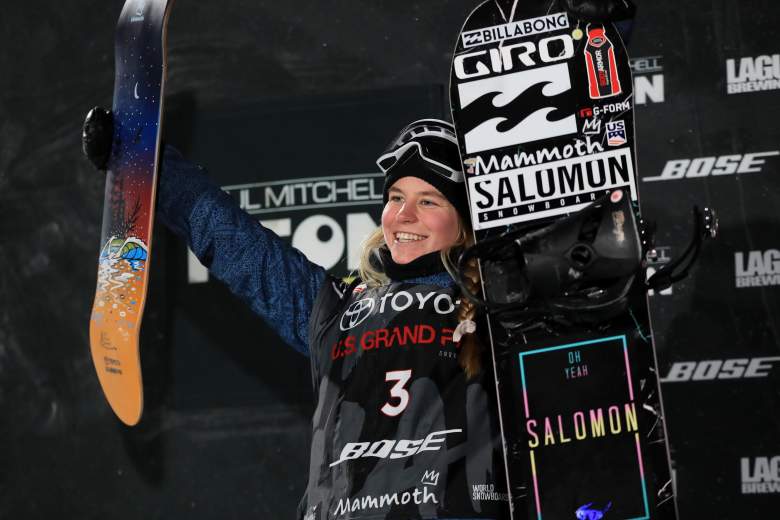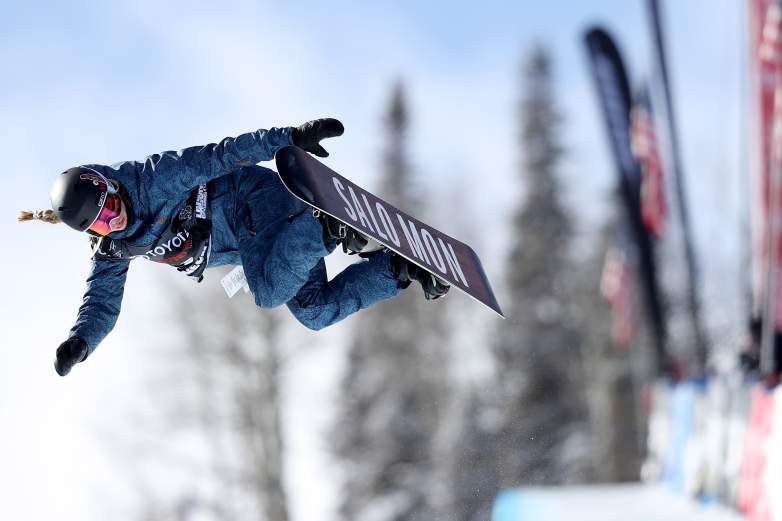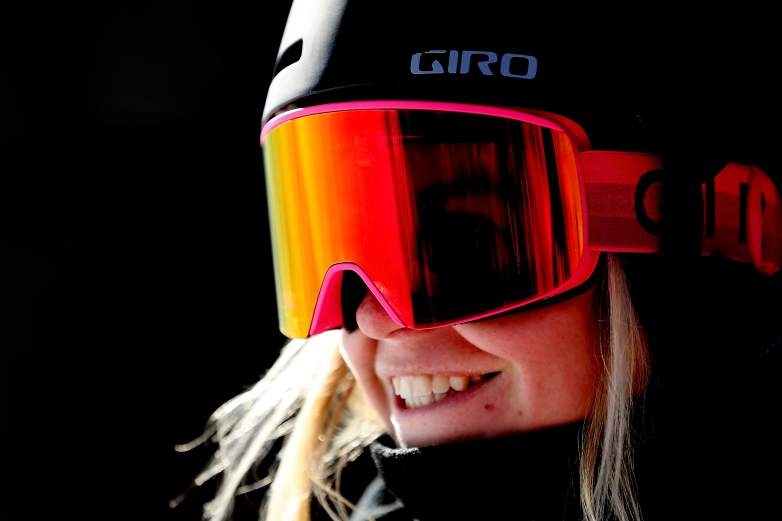
Getty Maddie Mastro after placing third in the final round of the Ladies' Snowboard Halfpipe during the Toyota U.S. Grand Prix on January 20, 2018
Heading into Monday night’s final in the women’s snowboard halfpipe, most of the attention will be directed towards American Chloe Kim, the frontrunner heading into the finals. But you’d be wise to not sleep on another American in the mix to medal in the event, Maddie Mastro. Mastro enters the finals in fourth place with a score of 83.75, which is more than ten points behind her U.S. teammate Kim and her 95.50 score. However, Mastro is only a couple of points behind Liu Jiayu of China, who is in second place, and Haruna Matsumoto of Japan, who is the less than a point ahead of Mastro.
The 2018 Winter Olympics is Mastro’s first time competing in the Olympics, but it’s certainly not her first rodeo when it comes to competing on a big stage. Currently ranked 9th in the world, the 17 year old Southern California native’s journey to PyeongChang has included multiple stops at U.S. Grand Prix events, the Burton U.S. Open, Winter Games New Zealand, the Copper Grand Prix and the Dew Tour.

GettyMaddie Mastro competes in qualifying for the Ladies’ Snowboard Halfpipe final during the Toyota U.S. Grand Prix on January 11, 2018
Specializing in the halfpipe, Monday will be Mastro’s only chance to bring home an Olympic medal in her first games. Here is what you need to know about Maddie Mastro.
1. Mastro’s Parents Got Her Into Snowboarding By Buying Her a Pink Snowboard
Mastro grew up in Wrightwood, California and began skiing at the age of 2. Four years later though, her parents, Christopher and Eileen Mastro, got their daughter hooked on snowboarding. All it took was a pink snowboard. Mastro remembers her early days snowboarding fondly and says that what first hooked her on the sport was the adrenaline rush that came with it.
“My earliest memory of snowboarding is actually of one of the weekends I was learning,” she has said. “I remember looking at my dad as he helped me turn from my heels to my toes. I was attracted to snowboarding because of the adrenaline rush I got when I was younger and hitting jumps and getting a feeling of flying.
Once she was locked in, Mastro began snowboarding at Mountain High and Big Bear, mountains in Southern California. When she was out there, she would usually meet up with future Olympias Kim and Hailey Langland.
“We were, like, the only three young girls on the mountain. So whenever we saw each other, you go and ride with them. Like, there’s another girl, let’s go ride with her,” Mastro says. “And it really helped push us all as we’ve gotten older. And still, to this day, all our snowboarding inspires and pushes each other.”
Mastro doesn’t remember much about her early days competing in tournaments, only “sitting on her dad’s knee complaining that her “stomach hurt.””
Mastro started competing in 2011, finishing second in the Slopestyle and fourth in the halfpipe at the USASA National Championships at Copper Mountain in Colorado in 2011.
2. After Watching Torah Bright at the 2010 Olympics, Mastro Knew She Wanted to Be in the Olympics
Mastro’s dreams of competing in the Olympics began when she was just ten years old and was watching Torah Bright of Australia compete at the 2010 Winter Olympics in Vancouver. Bright won the gold in the halfpipe that year, doing so with a near-perfect run in the finals.
Mastro was enamored with Bright and while watching her compete, “something just clicked,” Mastro says. Bright’s performance led Mastro to know that competing in the Olympics was what she wanted to do and later she wrote a note to Bright, a note that she still have in her room back home.
In an interview prior to the 2018 Olympics, Mastro said that Bright was her greatest source of inspiration, saying that “she is someone I look up to in everything she does. Her snowboarding is amazing, she has effortless style. And as a person, she is so kind and a genuine person.”
Mastro would have had to face Bright in PyeongChang if not for Bright getting injured. The injury resulted in Bright being left off the Australian team.
3. Mastro’s Family Had to Sacrifice A Lot For Her to Accomplish Her Dream of Competing in the Olympics
The decision to one day compete in the Olympics may have been a relatively easy one for Mastro, but getting there was the exact opposite. Mastro struggled early on to be recognized and avoid being overlooked at competitions. She was inspired by a quote her Mom wrote down once, “be so good they can’t ignore you.” Mastro has said that the quote “really helped push me to be noticed for my snowboarding and not get overlooked.” Another piece of advice her mom routinely gives her is “kick the ball hard,” which Mastro says translates to “try your best, and you will be fine.” Mastro’s mother says it to Mastro before every competition.
Mastro’s parents weren’t just there for emotional support early on, but financial support as well, something that is no small feat given the expenses that comes with competing on a regular basis. Before a rider starts pulling in sponsorships, it’s the parents who are usually footing the bill for equipment and the cost of travel to competitions.
“My family had to sacrifice a lot to help support me,” Mastro says. “My mom and I spent summer after summer applying to scholarships and foundations trying to get funds to help pay for me to be able to snowboard competitively.”
In the past years things have certainly gotten easier for the Mastro family, with Mastro becoming a member of both the Mammoth Mountain Snowboard Team and Team USA. She also is sponsored by Salomon, GIRO, Dakine, Billabong and Body Armor.
4. Mastro Has Become a Mainstay in Big Time Snowboard Competitions in Recent Years
Mastro began competing in tournaments about a year after the 2010 Winter Olympics. After the USASA National Championships in 2011, Mastro took part in the 2011 Burton US Open Junior Jam in Stratton, Vermont where she finished second in the halfpipe. She then went on to compete at a handful of stops on the U.S. Revolution Tour in 2014 and 2015, logging first place finishes in the halfpipe at the 2014 tour stop in Sun Valley, Idaho and twice in 2015, at Seven Springs, Pennsylvania and back at Copper Mountain in Colorado. Mastro also competed in two Burton US Opens, finishing tenth in the halfpipe in 2015 and then ninth in 2016.
2016 was a busy year for Mastro, who in addition to the US Open, competed at the World Snowboard Tour where she scored a fourth place finish in the halfpipe. She also competed at two Grand Prix events. At the Park City event she finished second, while at her home base of Mammoth Mountain she finished third. It was around this time that Mastro said she had her “breakthrough moment” and “realized I could truly achieve this.”
Mastro made her X Games debut in 2016, competing in the halfpipe three times, with her best finish comong in 2016 in Oslo, Norway. She finished in fourth place.
In 2017 Mastro finished in third place at the Burton US Open. She then recorded a third place finish at Winter Games New Zealand, a second place finish at the Copper Grand Prix and finally a fourth place finish at the Dew Tour before heading off to PyeongChang.
5. The Secret to Mastro’s Success Might Be Her Elaborate Pre-Competition Set of Rituals

GettyMaddie Mastro starts her competition days early and ends them with an episode of ‘The Office’
If you’ve ever watched a snowboarding competition, you’ll notice that for the most part, every rider goes through the same routine before their run starts. They check their boots, tighten their clothes, adjust their helmet and then give some love to the dude at the top of the ramp. It’s pretty straight forward. Mastro’s pre-run ritual is a little different though.
On Mastro’s bio page on NBC’s Olympics’ site, the ritual is said to involve “dancing and doing a secret handshake with her coach” before dropping in. But according to Mastro, it’s slightly more involved than that.
First, Mastro gets there early. She does this not because she has a desire to be punctual, but more because she hates “feeling rushed at contests.” This also gives her ample time to dance and sing, both of which she does non-stop.
“Then when I’m dropping in, I have a routine,” she says. “I strap in about five minutes or so before I have to drop in. I pick out my drop-in song and dance. I run through my run in my head and go through the motions. When it is my turn to drop, I do a secret handshake with my coach and slide to the drop-in. I stand looking at the pipe, then inhale a big breath, exhale and go. I shake my arms to get the wiggles out. I clap, then smile as I pop into the pipe.”
Mastro claims to do this routine at every competition and she follows it all up with episodes of The Office. As for any other quirks, Mastro wears a shoe lace around her pants. She believes “that my shoelaces are a good luck charm.” She also wears that same part of socks when competing.
Comments
Maddie Mastro: 5 Fast Facts You Need to Know